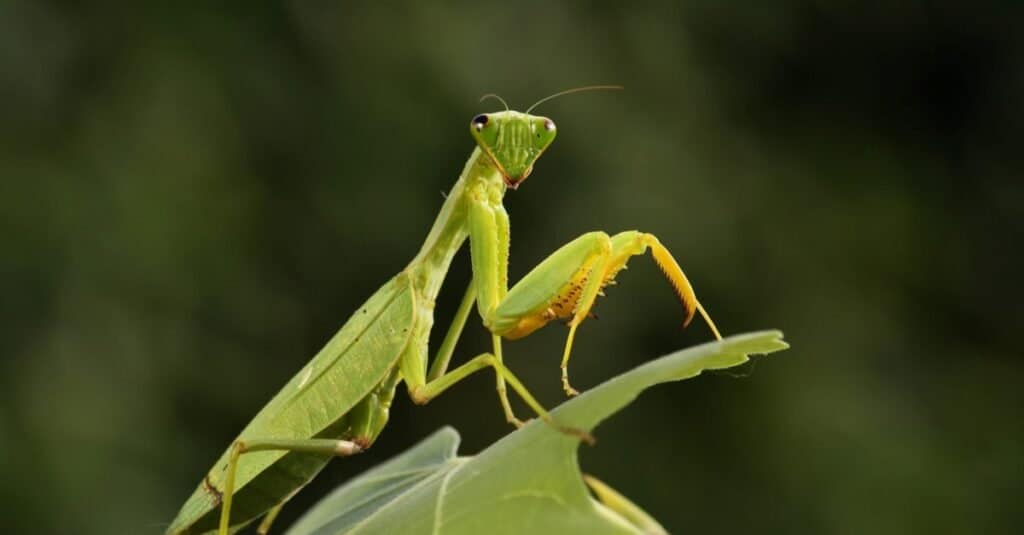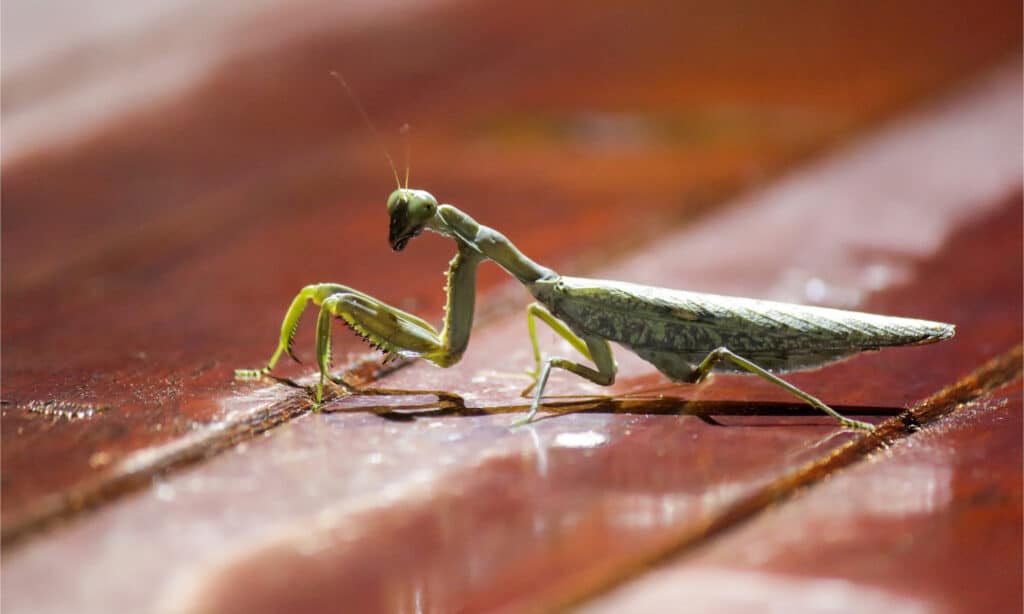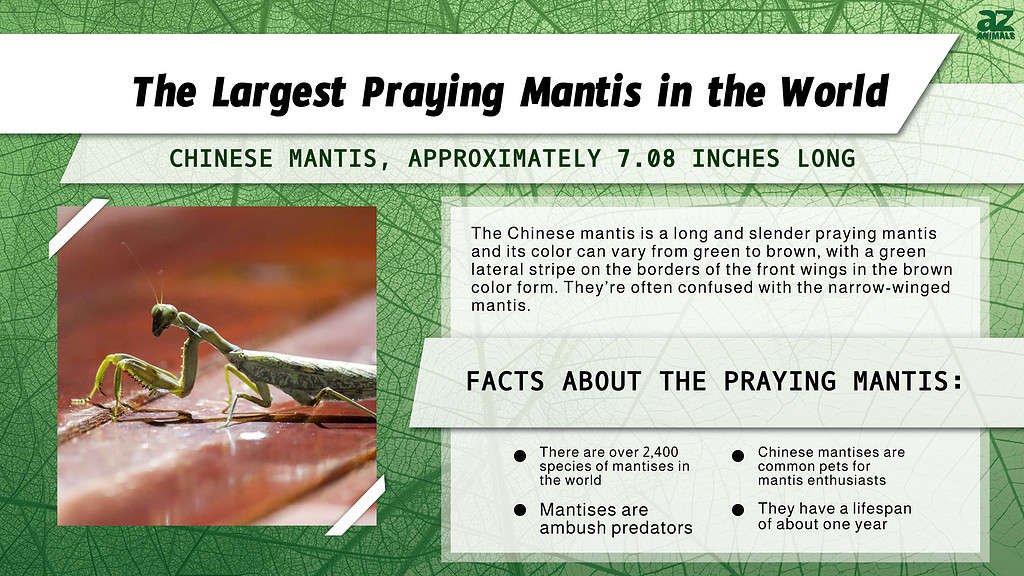Praying mantises exist on every continent on Earth, except Antarctica. They are found everywhere in the world, both in temperate and tropical habitats, though most species prefer tropical environments. Mantises are closely related to cockroaches and termites because they are believed to descend from a common ancestor, which is why they are sometimes grouped in the order Dictyoptera with the cockroaches. Although commonly placed in the suborder Mantodea of the order Orthoptera, mantises may also be placed in their own order, Mantodea. About 80% of all members of the order Mantodea belong to the family, Mantidae.
“Mantis” and “mantids” are commonly used interchangeably. Mantis refers to members of the genus Mantis such as the European mantis (Mantis religiosa), while Mantid refers to any of the large family of mantids. Similarly, the term “praying mantis” encompasses every member of the large family of mantids. Their name comes from the typical “prayer-like” posture with folded forelimbs, which they assume while patiently waiting to ambush their prey. For this reason, they are called the “martial artists of the insect world”!
This article explores how to identify a praying mantis and the different large species of mantis in the world. We’ll then take a look at the largest praying mantis in the world today –its size will surprise you! Finally, we’ll discuss if praying mantises can be kept as pets, what they eat, and the other animals that threaten their survival!
Identifying a Praying Mantis

Mantises have two spiked, grasping forelegs in which prey are caught and held securely.
©Karel Bartik/Shutterstock.com
Praying mantises are insects of the order Mantodea with prominent forelegs that are well-adapted for catching and gripping prey. Mantises have two spiked, grasping forelegs (also called raptorial legs) in which prey are caught and held securely. They assume a typical “prayer-like” position by remaining stationary in an upright position with the forearms folded – where their name comes from. They have triangular heads with two compound eyes supported on flexible necks, which can turn 18” degrees to scan their surroundings. Based on the presence of wings, mantises can be categorized as being macropterous (long-winged), brachypterous (short-winged), micropterous (vestigial-winged), or apterous (wingless). A winged mantis has two sets of wings. The outer wings, which are usually narrow and leathery, function as camouflage and as a shield for the hindwings, which are clearer and more delicate.
Largest Mantis Species: How Big Can Praying Mantises Get?

The largest known female Giant African Stick Mantis measured 6.77 inches in body length (males are usually around 157mm).
©Niney Azman/Shutterstock.com
There are over 2,400 species of mantises in the world — about 460 genera in 33 families. The largest family is the Mantidae, called “mantids.” Most praying mantises are no more than 5 inches long. Smaller individuals measure around 2 to 3 inches, while the bigger species reach an overall length of 6 to 7 inches. Depending on the age and species of the mantis, a praying mantis can grow more than 6 inches in size. Although some specimens have also been seen to reach lengths of about 20 cm. Among the largest of mantises is the Giant Asian Mantis (Hierodula membranacea), a member of the genus Hierodula which reaches around 2.8 to 3.5 inches (7-9cm).
Africa is also home to some of the largest mantis species in the world. The Giant African Stick Mantis (Ischnomantis gigas) is an incredibly long mantis species. The largest known female of this species measured 172 mm (6.77 inches) in body length (males are usually around 157mm). The West African Mega Mantis (Plistospilota guineensis) is considered the heaviest mantis species in the world, weighing about 13.08 grams (0.029 lb). Adult females of this species grow up to 11 cm long but are bulkier and heavier than those of the Giant Stick mantis.
The Largest Praying Mantis in the World Today!

Recorded to be approximately 7.08 inches (20 cm), the world’s largest praying mantis is the Chinese Mantis.
©samatcha Benjakanjana/Shutterstock.com
The world’s largest praying mantis is the Chinese Mantis, recorded to be approximately 7.08 inches (18cm) long, found in Southern China in 1929. Chinese mantis (Tenodera sinensis), a species of mantis native to Asia, was accidentally introduced near Philadelphia in the USA. The Chinese mantis is longer than any praying mantis species, reaching over 4.3 inches (11cm). Today, it is the largest recorded praying mantis in the world and the largest mantis in North America.
The Chinese mantis is a long and slender praying mantis and its color can vary from green to brown, with a green lateral stripe on the borders of the front wings in the brown color form. They’re often confused with the narrow-winged mantis. However, you can differentiate these two species by locating a spot in between their front legs. If the spot is yellow, then you’re looking at a Chinese mantis but if it is orange-colored, then it is a narrow-winged mantis. Chinese mantises hatch in the spring, eat, grow, and molt through the summer, and lay eggs at the end of summer. When it gets too cold, they die, with a lifespan of about one year.

Praying Mantis as Pets
Chinese mantises are common pets for mantis enthusiasts, and their ootheca can be purchased from plant nurseries across the US. They are easy to care for and relatively fun to be around. They quickly adapt to human presence and can become tame enough to perch on one’s hand and even be hand-fed. When captured, a Chinese mantis should be kept in a terrarium roughly three times its body size. The Chinese mantis is an aggressive carnivore that will tackle and eat large insects. In captivity, the Chinese mantis’ diet can consist primarily of grasshoppers, cockroaches, crickets, moths, and butterflies. In the terrarium, water should be provided for them daily and there should be proper aeration. Mantises thrive in temperatures ranging from 20 to 38 °C.
What Do Praying Mantises Eat?
The primary source of food for praying mantises is arthropods. Mantises are ambush predators that only eat live prey within their reach. Once within reach, mantises strike rapidly to grasp the prey with their spiked raptorial forelegs. Larger mantises sometimes eat smaller individuals of their own species, as well as small vertebrates such as lizards, frogs, fish, and small birds, particularly hummingbirds. Because of how large Chinese mantises are, the foregut extends its whole length and can be used to store prey for later digestion. They live longer, grow faster, and produce more young when they’re able to eat pollen. An interesting fact to know is that the female mantis practices a strange phenomenon called sexual cannibalism, where she kills and eats her male partner after mating. The reasons for this remain largely unknown.
What are the Common Mantis Predators?
Mantises are preyed on by vertebrates such as frogs, lizards, and birds, and by invertebrates such as spiders, large species of hornets, and ants. The Chinese mantis is preyed on by other mantises, especially the Asian giant hornet in its native range. Some species of hunting wasps, such as Tachytes, also feed on young mantises by paralyzing them. To avoid predators, most mantises employ camouflage. They may change their color to resemble foliage or other backgrounds. When directly threatened, many mantis species stand tall and spread their forelegs, with their wings fanning out wide. The fanning of the wings makes the mantis seem larger and more threatening.
Thank you for reading! Have some feedback for us? Contact the AZ Animals editorial team.








